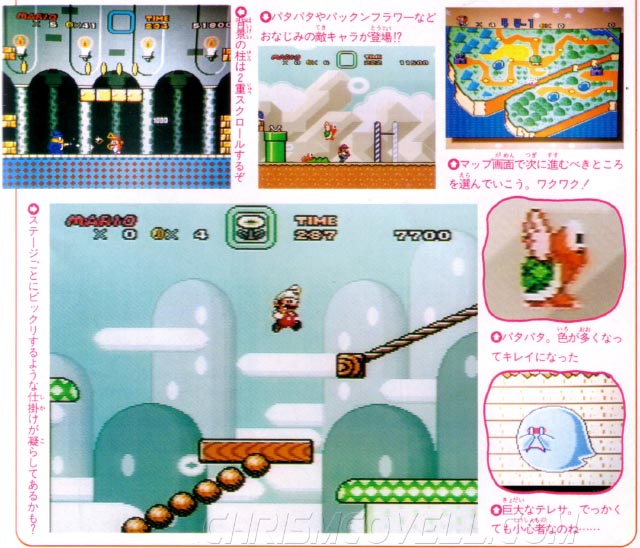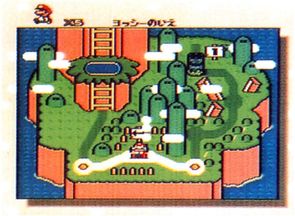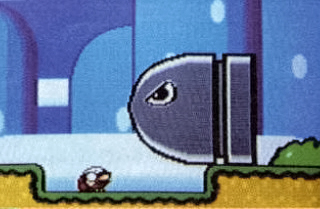Prerelease:Super Mario World (SNES)
This page details prerelease information and/or media for Super Mario World (SNES).
| To do: More scans from unknown magazine(s): |
Super Mario World had an interesting development, starting out in 1988 with a very different overworld and closer connections to Super Mario Bros. 3. The game was built off of a port of Super Mario Bros. 3 that was created to test the Super Famicom's hardware capabilities.
Contents
Development Timeline
- October 1988 - Development for Super Mario World begins after the release of Super Mario Bros. 3 in Japan.
- July 28, 1989 - The game is revealed at the Shoshinkai private press event in Japan.
- January 1990 - The game is said to have reset development around this time.
- November 21, 1990 - The game is released in Japan.
- August 13, 1991 - The game is released in North America.
- April 11, 1992 - The game is released in Europe.
1989 Builds
Press Conference Reveal
At least two early builds of Super Mario World were shown on July 28, 1989. These are photos taken off the projector screen, published in 1989 issues of Famitsu and Famimaga. While some elements are pretty much done even at this early point, others were changed - some significantly.
It is almost certain that the "1989 Shoshinkai" was a private event, open only to members of the press.
Various remnants of early development, including some elements shown below and some that aren't, are present in the final game, the SNES Test Program, and the SNES Burn-In Test Cart. Many more graphics assets were found among the 2020 Nintendo leaks, and are covered here.
The only known differences between the two builds seen are Mario's sprite work and one of the levels having a background change.
Earlier Build
Features Mario with red shoes and no gloves, similar to Super Mario Bros. 3. There are also visible eyebrows and a smiling expression on his face during the jumping and running animations.
Title Screen
| Early | Final (Japan) |
|---|---|
 |
 |
Colors aside, the logo is pretty much exactly the same as the final Japanese version, as is the wood border (although the border is one block taller here). Behind the logo, however, is a brown map-style drawing of the mushroom-shaped island used as the overworld at this point in development. An oversight present in this title screen is that one of the tiles to the left of the "W" is incorrectly flipped vertically.
Overworld
Very different than the final, aside from the border and Mario's overworld sprite. On the top side of the border is Small Mario walking (albeit using very different sprites), the lives counter, the stage number (using a World-Level style similar to the pre-Super Mario Bros. 3 games), and (for whatever reason) coin and score counters.


There are four "Worlds", at least three of which have a Fortress (seemingly looking no different than the final) at the end. The domed mushroom-like house is clearly a starting point, not unlike the START tiles of Super Mario Bros. 3, with World 2 to the right.
Interestingly, the prologue cutscene of Super Mario World: Super Mario Advance 2 ends with a shot of the first world as it appears in the in-game overworld before fading to a brown map-style drawing of it, after which the logo appears.
HUD, Powerups, and Backgrounds
The backgrounds of the outdoor areas are similar to those used in the final, aside from the presence of circular "donut" clouds. Judging from their positioning between shots, they were likely implemented as a separate independently-scrolling background layer.
The HUD is very similar to the final version. Only the Bonus Star counter is missing, with the coin counter in its place rather than above the score, and the lives counter is right-justified rather than centered. The reserve box color is also a teal color in some shots.
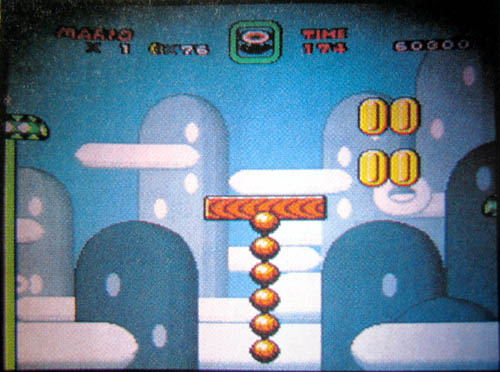
Large coins similar to the Dragon Coins are present, though whether they actually are Dragon Coins is unknown. A common feature in early screenshots is round, donut-shaped clouds in the background. The Fire Flower resembles its appearance in Super Mario Bros. 3, albeit with a miscolored pixel in the middle. The top of the spinning platform is also much thicker and has 6 pivots instead of 5.


The ? Blocks resemble those used in Super Mario Bros. 3, as do the wood blocks, which were ultimately removed from the final version.

The Super Leaf from Super Mario Bros. 3 is present at this point, as is Raccoon Mario. The final game replaced them with the Cape Feather and Cape Mario. The triangle block looks more mechanical than the final version, which was made magenta and given a face. The top corner of the hill is also more rounded, possibly to accommodate the triangle block. Mario's horizontal sprite was redrawn to be somewhat squashed in the final game, likely to account for the console's slightly odd aspect ratio.
Grassland
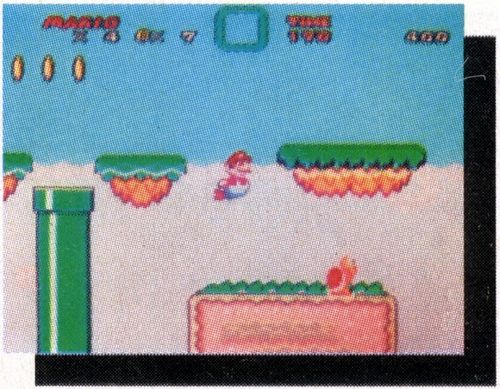
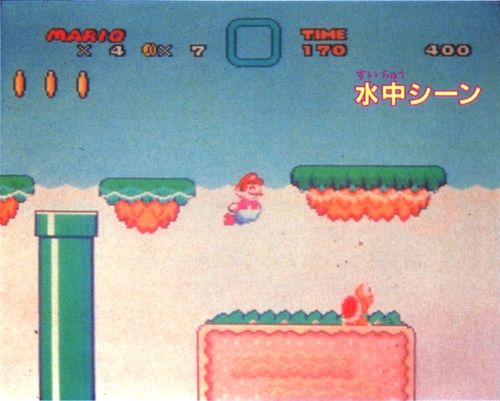
This screenshot appears to be of an early version of the level Mondo.
The Koopa Troopa looks more like the one in Super Mario Bros. 3, although they tend to not appear underwater in the final game. The larger floating platform is unused in the final game but only acts like the smaller floating platforms if Sprite Buoyancy is enabled in the current level, which along with the Koopa suggests that the "rising and falling water" mechanic was already in place at this point.
This level also appears to use the level mode "1F", which is one of two unused level modes that have the ability to make layers translucent. These modes can still be found in the final game.

To the left, you can see a Brick Block with a Blue Koopa next to a pipe with a "classic" upward-facing yellow Piranha Plant (also unused in the final game). The Beach Koopa in this shot is barefoot, matching the appearance of the classic Koopa Troopas. The tape of the midway point is also much thinner.
Castle


The floor and background are slightly different, along with a somewhat out-of-place wood block.
Later Build
Mario's appearance in the later build is much closer to the final game but still has some differences. The brim of the player's cap is black in the final game, while in this build the color of the brim matches the rest of the cap.
Overworld
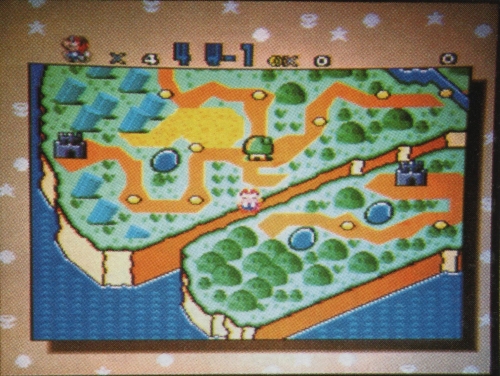

The bottom path is World 4 in this early overworld. It's also clearer from these screenshots that the overworld layout resembles a mushroom.
We can also see that the mosaic effect was programmed into the game relatively early on.
HUD

This shot is somewhat odd, as it seems to be an attempt at recreating an older shot with slightly newer assets. Most notably, Mario's jumping sprite does not have the open mouth seen in the older design.

An early version of the score tally after clearing a stage. Next to "MARIO" is the cleared course number ("4W-1" in this case). Notably, "COURSE" is missing its R.

An early version of the "MARIO START" text. Notable differences are the lack of a black background, showing the start of the level, it also shows the course number (that being "4-4") and the "MARIO START" text does not use custom sprites, instead, it uses the same letters from the HUD.
Grassland

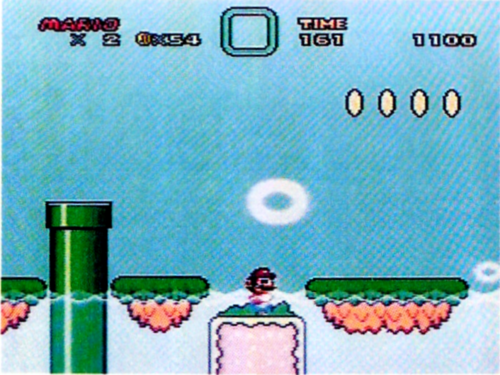

This screenshot appears to be the same level but on a later build of the game, here you can see the early Cheep Cheep sprites in use along with the Donut shaped clouds, which are present in the previous build but are hard to make out in the available screenshot. In the second screenshot, the water height is different from the rest of them, which indicate that the "rising and falling water" mechanic was already implemented at this point.

Here's another recreation of an older shot with newer assets. When compared with the earlier version of the shot, it can be noted that the background palette was altered, the hills are now colored white instead of blue, and the midway point's tape has been altered to be thicker, matching its appearence in the retail game.
Castle

The floor and background look slightly different, just like the previous build.

There's a lack of lava in this level, which is usually present in castle levels.

Here it's apparent that there are only green Climbing Koopas on the net, the final game has a red variant of the enemy which has faster movement.
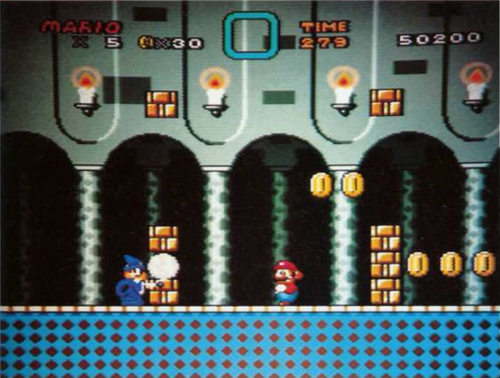

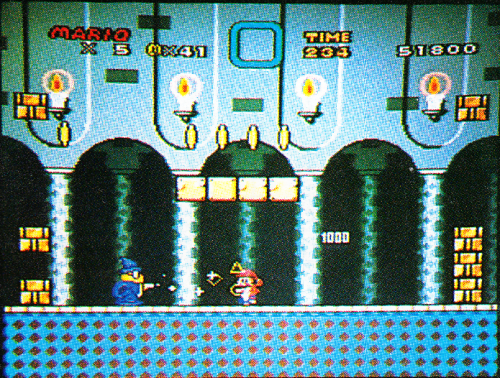
Again, the floor and background are slightly different, and Super Mario Bros. 3-style Brick Blocks are used instead of the final's Turn Blocks. Magikoopa looks like he does in the final, as does his attack. Judging by the angle of his magic in the first screenshot, it should've hit the brick block and changed it into a Koopa. This either means that Magikoopa projectiles could go through Blocks, or their hitbox was much smaller. Note the dark-blue discoloration of his robe, the result of a palette bug that still exists in the final game.

Another screenshot of this castle. A yellow Koopa Troopa is present, confirming the 4 different Koopa colors were already implemented fairly early on.


This screenshot shows an early Koopaling "tilting platform over lava" battle. The lava is one tile higher, which means the tilting platform is deeper in it. The Koopaling seems to more clearly resemble its Super Mario Bros. 3 style and is most likely Larry Koopa given its palettes and appearance, though Larry never jumps in his boss battle in the final game.
Stages

Mario getting hit by a Paragoomba from Super Mario Bros. 3 (replaced with Winged Galoombas in the final game), which also shows that the reserve item box works the same way it does in the final. The pipe also has a slimmer design more reminiscent of Super Mario Bros. 3.
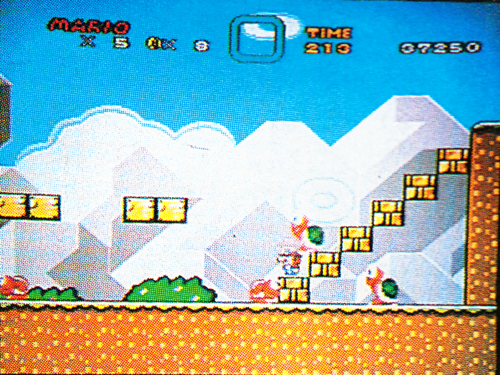
Mario standing on a stair of Brick Blocks with a Koopa next to him.

Mario crouching under the Brick Blocks. A star was inside the middle one.

Mario getting hit by a Venus Fire Trap, an enemy that doesn't appear in the final game. By taking a closer look, you can see that Mario is in his shrinking animation.

Mario being confronted by a barefoot Beach Koopa. The Super Mario Bros. 3-esque ? Blocks can be seen up close.
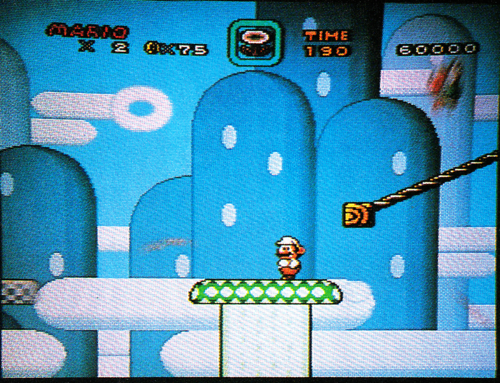
Checkerboard platforms, like the top of the spinning platforms, were much thicker in this build.

Mario picking up a Super Mushroom on what appears to be the same level seen in the Raccoon Mario screenshot from the previous build.

Two screenshots taken 4 seconds apart, which clearly show that the donut-shaped clouds scrolled independently from the camera. The red arrow is actually incorrect, the image on the left takes place before the one on the right.
Ghost House/Test Level
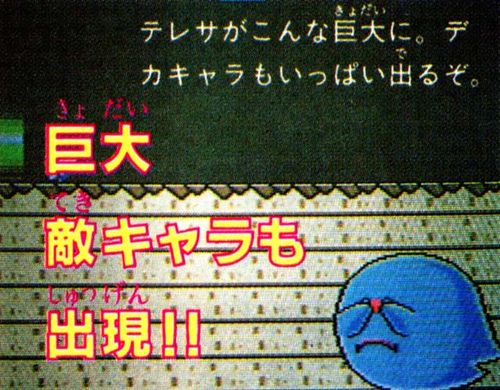



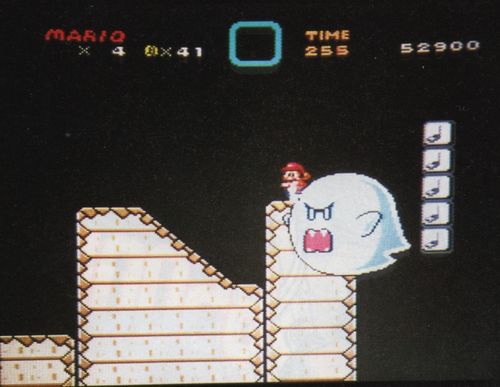
Big Boo looks pretty much like it does in the final, as do the Note Blocks. There's no background at this point and the level design looks amateurish, which may indicate this could have been a test level and not a proper Ghost House.
The ground tiles found a home in the fortress and castle tileset in the final game, though the dirt-like spotted interior was replaced with a diagonal brick pattern and the slopes were removed to make room for other graphics. Leaked internal material indicates that the ground tiles were seemingly supposed to be an early version of the underground tileset.
The first screenshot shows that the hurt animation is bugged, displaying the bottom half as Small Mario. This same visual glitch can also be seen in both of the Magikoopa screenshots.
Other Scans
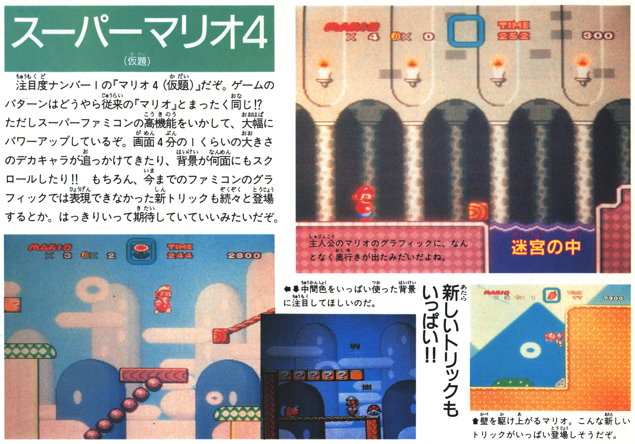

A few new shots along the bottom:
- Though the arrow indicates that the fourth picture is the score tally following a boss battle, the different coin count, "4W-1", and Mario's victory pose suggest otherwise.
- The first screenshot is another shot of the Magikoopa castle stage with Brick Blocks.
- An early Paratroopa with smaller wings can be seen in the second shot.
- At the bottom-right seems to be another shot of the early Ghost House/presumed test level.
- The life counter reads 0, much like how SMB3's life counter system works.
SFC Mini Interview Spritesheet
| Prerelease Screenshot | Recovered Sprite Sheet |
|---|---|

|
In SFC Mini interview #5: Super Mario World & Yoshi's Island, an early design for Yoshi was revealed along with some other work-in-progress sprites, including Nipper Plants, Chain Chomps, Sledge Bros., and standard Hammer Bros. - all enemies from Super Mario Bros. 3 that didn't make it into the final game. The presence of an upright Koopa Troopa frame suggests that these graphics were created sometime after most of the early screenshots were taken; however, they are clearly not finished, as the Hammer Bro's inconsistent presence of shoes attests to. The early adult Yoshi design bears a rather close resemblance to the final baby Yoshi sprite. The P-Balloon is also red instead of yellow, and the key is vertically flipped.
The original sprite sheet was found among the July 2020 Nintendo leaks, named chr-stock-2.cgx and dated November 29, 1989.
While Chain Chomps, Sledge Bros., and standard Hammer Bros. do appear in the Super Mario World style of the Super Mario Maker games, their graphics are completely different from the ones seen here.
1990 Builds
Videos
Famicom Space World 1990
While the video title and description say this footage is from the 1990 Tokyo Toy Show, this footage actually comes from Famicom Space World '90, which took place in August of that year. It's also important to note that 2 builds are seen in this footage: a near-final playable demo, and a much earlier build that was showcased in video format, they'll be separated accordingly.
Video Showcase Build
- A different title screen can be seen at 04:05, the level running in the background looks completely different. It's unknown if it's simply a mockup created to showcase the Super Famicom's layers or if it is based on an early rendition of the title screen.
- At 04:50 Yoshi's House can be seen, the title screen music plays and a glitched-out Yoshi can be seen in the middle of the level, additionally, a text box appears even though there are no Message Blocks in the stage. The stage itself has small changes like the missing Message Block mentioned previously, the inclusion of red, pink and green berries instead of only red berries and the background seems to be 8 pixels higher when compared to the final.
- At 04:52 Mario can be seen moving down from the Yellow Switch Palace but the stage name is "ヨースターとう コース1" (Yoshi's Island 1), it seems that level didn't have a unique stage name. Additionally, the overworld here is an early rendition that is missing grass pieces, has simpler island edges and is missing the signs that indicate the world the castles are from. The unused overworld Lakitu object can be seen implemented here as well. Lastly, the lives counter and level name are positioned differently from the final game, further away from each other.
- The bonus points counter in the status bar is placed further to the left, with the star pressed right up against the lives counter. That same star is colored differently, being white instead of red.
- When stomping Galoombas, the sound for spin jumping a spiked object would play (can be heard at 03:01).
- Yoshi may use early graphics from v-ram-yama with whiter cheeks, though it's hard to tell due to the blurriness of footage.
- When Yoshi is standing still he doesn't do the "hopping in place" animation seen in the final game, remaining completely idle instead. This change can be seen at 03:02.
- At 01:58 and 02:09 Mario can be seen collecting Dragon Coins, but the status bar doesn't count them, it appears as if the Dragon Coin counter wasn't yet implemented.
- Banzai Bills use a different sprite that can be found in the gigaleak under the name v-ram-big-killer.
- Yoshi's Island 1 uses different background graphics and different palettes for the hills and sky. This level also features small layout differences, these include:
- After the first Banzai Bill in the stage there's a gap that was removed in the final game (can be seen at 03:40).
- At the end of the level there's an extra Rex at the hill above the last Banzai Bill and right next to that hill, there's a Dragon Coin that was later moved to be above the last hill (can be seen at 02:06 and 03:42).
- Donut Ghost House uses a different background palette, this different palette is used in the final game in stages like Donut Secret House (can be seen at 02:10 and 03:46).
- Eeries didn't have unique graphics, instead they used Boo's sprites (can be seen at 02:17 and 03:53).
- Iggy's castle uses a different tileset for the floor, this tileset can be found in the gigaleak under the name chr-stock-G.CGX (can be seen at 03:38 and 04:20). Additionally, Climbing Koopas are placed differently in the stage, there are more of them at the end of the first room and they're all green.
- When pillars hit the floor they don't shake the screen (can be seen at 03:39).
- Morton's Castle can be seen at 04:40, it features small level design and visual changes, these are:
- In the start of the crushing walls section there's a ? block with a cape feather inside which was eventually removed.
- The small path to the left of the crushing walls is missing a Dry Bones at the end of it.
- The Dry Bones right after the crushing walls section are missing and it seems like the three ? Blocks above them are missing too.
- The background is about 8 pixels higher when compared to final.
- Gray Blocks use an early sprite reminiscent of Super Mario Bros. 3, found in the gigaleak under the name v-ram-yane.
Playable Demo
- Donut Plains 1 uses a different background palette with a blue sky (can be seen at 00:06).
- The unused overworld Lakitu object can also be seen implemented here, though its functionality appears to be identical to final (can be seen at 00:21).
- Overworld Mario's sprite is down a few pixels when compared to final (can also be seen at 00:21).
- The overworld map uses a different layout that's missing grass pieces and has simpler island edges (once again it can be seen at 00:21).
- There appears to be a small highlight to the right of the Ghost House sign (seen at 1:47).
Screenshots
Overworld
| Prerelease | Final |
|---|---|

|

|
An early version of the final overworld map.
- The edges for islands are much simpler.
- Many grass pieces were replaced with small hills.
- The small grass area below Cheese Bridge is a straight line.
- Small hills are not present in the Forest of Illusion and Chocolate Island areas.
Yoshi’s Island
| Prerelease | Final |
|---|---|

|

|
An early version of the Yoshi’s Island overworld map. It doesn’t have any rocks or bushes in the place where the large hill rises after beating Yoshi’s Island 1 and is just grass instead. It contains all differences seen in the Shoshinkai 1990 footage, like the missing sign next to Iggy's Castle, overworld Mario's lower vertical position and the lives counter and level name being further away from each other.
Another screenshot of the Yoshi's Island overworld map. The rocks and bushes are still missing, but it has the numbered sign and the positions for the life counter and level name now match the final game.
An early version of Yoshi's Island 1. The sky is yellow, unlike the blue color of the final game, and the bonus points counter in the status bar is placed further to the left and takes up less space horizontally, with its star icon seemingly missing. In addition, an early, less menacing design for Banzai Bill, featuring a dull grey palette and no mouth, can be seen here, it is closer in appearance to Bullet Bills.
Another Yoshi's Island 1 screenshot. While this is a later build, indicated by the bonus points counter having its final position (although still having the smaller size of the previous build), the background differs more from the retail game than the previous version, it uses different graphics and palettes for the sky and hills. The star icon in the bonus points counter is colored white instead of red, there's a Rex on top of the hills that was later moved down to the ground and the early Banzai Bill sprite can be seen again here.
This screenshot showcases a near-final version of Yoshi's Island 1 with a finalized background, Banzai Bill's early sprite can be seen here as well.
Banzai Bill's early design can be seen yet again here.
| Prerelease | Final |
|---|---|
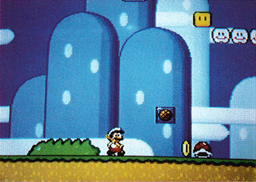
|

|
This near-final version of Yoshi's Island 1 has a minor level design difference, the trail of clouds after the block with the 1up mushroom is placed 1 tile further to the left.
| Prerelease | Final |
|---|---|

|

|
A Galoomba in Yoshi's Island 2, in the final game, there are no Galoombas in this level.
| Prerelease | Final |
|---|---|

|

|
This screenshot shows a unknown underground sub-area, which could be an early version of Yoshi's Island 2, as the yellow shell is positioned where the grab blocks are in the final version.
| Prerelease | Final |
|---|---|

|

|
An early version of Yoshi's Island 3 with a different foreground palette.
| Prerelease | Final |
|---|---|

|
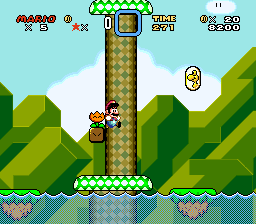
|
The mushroom platform under the first ? Block in Yoshi's Island 4 was smaller, which caused a tiling error on the right side of the platform.
| Prerelease | Final |
|---|---|
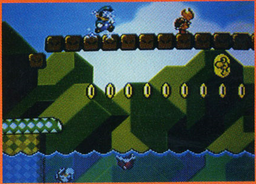
|

|
This section of Yoshi's Island 4 has some small level design changes, these include:
- The Empty Block trail is placed 4 tiles lower. The first block in that trail is placed one tile lower.
- The Coin trail is one tile further away from the mushroom platform.
- At first it may seem as if the block containing the Super Star is missing, but it actually appears to be placed farther back as in the screenshot Mario has collected a Super Star.
- According to this screenshot, the Pokey subarea may be missing, since the pipe from which you exit that subarea from is absent.
Donut Plains
| Prerelease | Final |
|---|---|

|

|
Just like in the Shoshinkai 1990 footage, Donut Plains 1 uses a different background palette, with a blue sky. In addition, Mario's cape uses a different, simpler sprite. This early graphic can be found in the July 2020 gigaleak in a file named X-Q-X-back.CGX.
Chocolate Island
| Prerelease | Final |
|---|---|

|

|
An early version of Chocolate Island 2, using different, regular palettes for the foreground and background rather than the brown mountain palettes used in the final game. The Dino Rhinos and Dino Torches look different, being shown in a profile view rather than the 3/4 view of the final. There are more Dino Torches in this section than in the final game.
Sunken Ghost Ship
| Prerelease | Final |
|---|---|
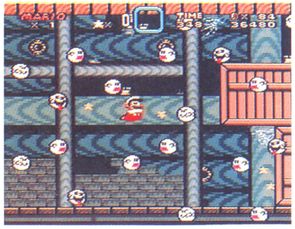
|

|
An early version of the Sunken Ghost Ship. The topmost wooden box is taller and wider than the final game.
US Version
Early Western Logo
Two US commercials for the game show that, at one point, the US version used the same logo as the Japanese version, albeit with "Super" above "Mario" and "SUPER MARIO BROS. 4" next to it. This logo arrangement and subtitle originally appeared on the Japanese box and label art. Interestingly, the logo for the DiC Super Mario World cartoon (which was produced alongside the US version of the game) also has "Super" above "Mario".
The "SUPER MARIO BROS. 4" sprite can be found in the graphics data of the game's non-Japanese releases only.
| Japan Retail | "SUPER MARIO BROS." Subtitle | Found in Gigaleak |
|---|---|---|

|

|

|
| "SUPER MARIO BROS. 4" Subtitle (1991) | Near Final + No Copyright | Final US |
|---|---|---|

|
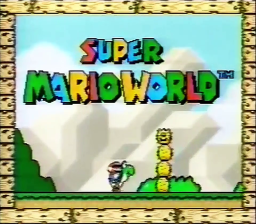
|

|
The first early title screen not only doesn't show the 4 but also doesn't have the copyright info. Given that the later "SUPER MARIO BROS. 4" shot has both of these, it's possible that neither was ready at that point or a bug prevented them from appearing on the title screen. The early US title screen is also missing grass tiles on top of the ground.
Font
| Early | Final |
|---|---|
The font used for message boxes and overworld level names differs slightly from the final version. From the level names shown in the commercials, we can tell that the capital letters "Y", "A", "N", "V", "M", and "G" are differently shaped, as is the number "4". This font can be seen used in a dumped localization prototype.



